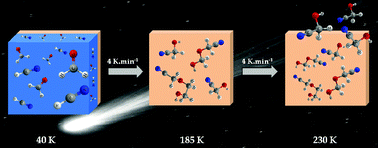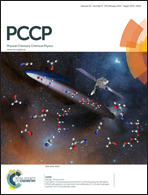Formation of hydroxyacetonitrile (HOCH2CN) and polyoxymethylene (POM)-derivatives in comets from formaldehyde (CH2O) and hydrogen cyanide (HCN) activated by water
Abstract
Studying chemical reactivity is an important way to improve our understanding of the origin of organic matter in astrophysical environments such as molecular clouds, protoplanetary disks, and possibly, as a final destination, in our solar system bodies such as in comets. Laboratory simulations on the reactivity of ice analogs can provide important insights into this complex reactivity. Here, the role of water as a catalytic agent is investigated under the conditions of simulated interstellar and cometary grains in the formation of complex organic molecules: the hydroxyacetonitrile (HOCH2CN) and formaldehyde polymers (polyoxymethylene POM). Using infrared spectroscopy and mass spectrometry, we show that HCN reacts with CH2O only in the presence of H2O, whereas in the absence of H2O, HCN is not sufficiently reactive to promote this reaction. Furthermore, depending on the dilution of CH2O and HCN in the water matrix, 1-cyanopolyoxymethylene polymers can also be formed (H–(O–CH2)n–CN, POM–CN), as confirmed by mass spectrometry using the HC15N isotopologue. Moreover, quantum chemical calculations allowed us to suggest mechanistic proposals for these reactions, the first step being the activation of HCN by water forming H3O+ and CN−, which subsequently condense on a neighbouring CH2O promoting the formation of −OCH2CN. Once −OCH2CN is formed, it can either recover a proton by reacting with H3O+ or condense on CH2O molecules leading to POM–CN structures. Implications of this work for the forthcoming Rosetta mission are also addressed.

- This article is part of the themed collection: Astrochemistry

 Please wait while we load your content...
Please wait while we load your content...